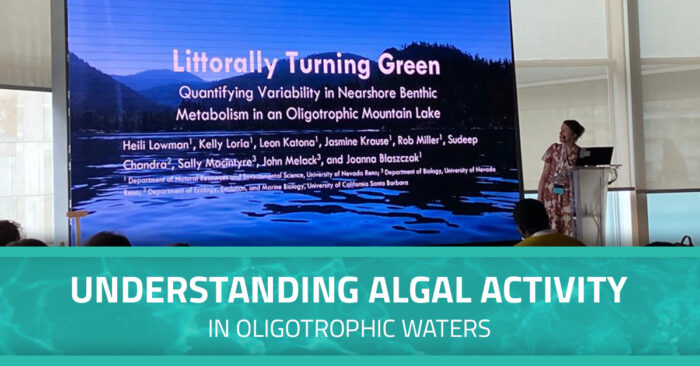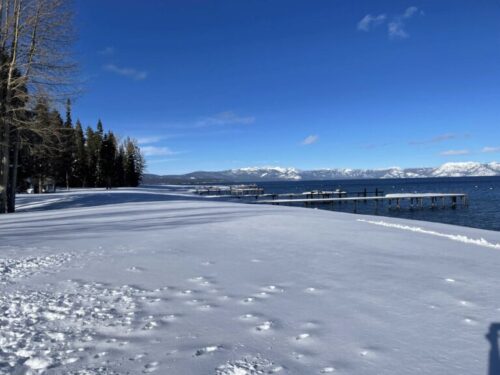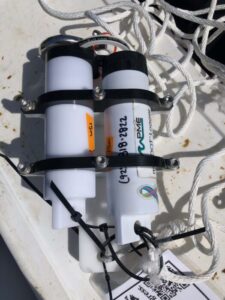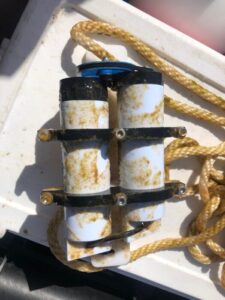The miniDOT® Logger is a completely submersible instrument that logs dissolved oxygen and temperature measurements. Data is recorded on the internal SD card and operational functions, like setting time and sample intervals, can be accomplished via USB cable. The oxygen sensor is an optode that measures dissolved oxygen concentration in water through a fluorescence method. The miniDOT® can withstand temperatures ranging from 0 – 35°C with a depth rating of 300 meters.

The Marvelous Missing miniDOT®
June 13, 2023
miniDOT® Loggers in East Africa’s Mara River
September 14, 2023Understanding Algal Activity in Oligotrophic Waters
Project Details
- PRODUCT(S): miniDOT® Logger
- APPLICATION: Surface Water
- PARAMETER: Dissolved Oxygen, Temperature
- LOCATION: Lake Tahoe
- ORGANIZATION: University of Nevada, Reno
- RECOGNITION: Heili Lowman

Introduction
Dr. Heili Lowman is a post-doctoral scholar and member of PME’s New Researcher Program studying aquatic ecology and biogeochemistry at the University of Nevada at Reno. Dr. Lowman and her colleagues have been monitoring Lake Tahoe since late 2021, and in June of 2023 she traveled to Palma, Spain, to present her recent data to the Association of the Sciences of Limnology and Oceanography (ASLO). In her talk “Littorally turning green: Quantifying variability in nearshore benthic metabolism in an oligotrophic mountain lake,” Dr. Lowman offered initial estimates and findings on her still ongoing study.

Algae at Unexpected Altitudes
Between the border of California and Nevada lies Lake Tahoe. At an elevation of approximately 6,230 feet, this scenic mountain lake is the third deepest freshwater lake in North America. Despite attracting millions of visitors annually, some of the lake’s newer arrivals have prompted concern among the members of the scientific and local communities. Algae is a natural feature in many bodies of water, but excessive quantities can indicate underlying ecological issues and trigger disruptions in the ecosystem. Oligotrophic mountain lakes such as Lake Tahoe are known for their clarity because they typically lack the nutrients to support excessive algal growth or blooms, marking this recent increase in algae as highly unusual.
Dr. Lowman and her colleagues are currently conducting a long-term study focusing on the near-shore regions of Lake Tahoe to uncover any patterns in primary production so they may better understand the driving cause behind the increased algal growth.
Monitoring & Methodology
Between the border of California and Nevada lies Lake Tahoe. At an elevation of approximately 6,230 feet, this scenic mountain lake is the third deepest freshwater lake in North America. Despite attracting millions of visitors annually, some of the lake’s newer arrivals have prompted concern among the members of the scientific and local communities. Algae is a natural feature in many bodies of water, but excessive quantities can indicate underlying ecological issues and trigger disruptions in the ecosystem. Oligotrophic mountain lakes such as Lake Tahoe are known for their clarity because they typically lack the nutrients to support excessive algal growth or blooms, marking this recent increase in algae as highly unusual.
Dr. Lowman and her colleagues are currently conducting a long-term study focusing on the near-shore regions of Lake Tahoe to uncover any patterns in primary production so they may better understand the driving cause behind the increased algal growth.
Current Conclusions & Ongoing Observations
While their research remains ongoing, Dr. Lowman has reached some preliminary conclusions. Initial findings indicate the rates of productivity are roughly the same on either side of the lake, however discrepancies in timing reemphasize near-shore areas are unique and diverse even within a single body of water. Furthermore, Dr. Lowman suspects the shape of the lake and surrounding watersheds are contributing factors to the differences observed between the shores. Where the eastern shore is flanked by steep mountains, its bathymetry, or topography of the lake bottom, reflects a very gradual slope to the lake’s center. Conversely, the lake floor rises steeply on the western shore, which is flanked by far less-severe mountaintops. These contrasting landscapes likely influence how water enters and mixes in the near-shore areas, influencing the algal growth and primary production in the shallow waters. Although more observation is necessary to confirm these hypotheses, Dr. Lowman and her colleagues are already looking ahead to future avenues of inquiry in the area.



